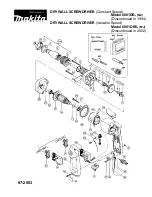
Page 73
EA Elektro-Automatik GmbH
Helmholtzstr. 31-37 • 41747 Viersen
Germany
Fon: +49 2162 / 3785-0
Fax: +49 2162 / 16230
www.elektroautomatik.de
EL 9000 B 15U/24U Series
3.10.13 Battery test function
The purpose of the battery test function is to discharge various battery types in industrial product tests or labora
-
tory applications. It is only available via access on the HMI, at least as setup and use are described below, but can
also be achieved in remote control using the arbitrary function generator. The only disadvantage in remote control
are the missing counters of battery capacity (Ah), energy (Wh) and time. But those can be calculated by custom
remote control software when programming a time counter and regularly querying actual values from the device.
The function is usually applied on the DC input current and can either be selected and run in “
Static
” (
constant
current
) or “
Dynamic
” (
pulsed current
) mode. In static mode, the settings for power or resistance can also let
the device run the function in constant power (CP) or constant resistance (CR). Like in the normal operation of
the load the set values determine what regulation mode (CC, CP, CR) is resulting on the DC input. If, for example,
CP operation is projected, the set values of current should be set to maximum and resistance mode should be
turned off, so that both don’t interfere. For a projected CR operation it is similar. There current and power should
be set to maximum.
For dynamic mode there is also a power setting, but it cannot be used to run the dynamic battery test function in
pulsed power mode or at least the result would not be as expected. It is recommended to adjust the power values
always according to the test parameters, so it doesn’t interfere with the pulsed current, i. e. dynamic mode.
When discharging with high currents, compared to the nominal battery capacity and in dynamic mode, it may hap
-
pen that the battery voltage shortly drops below the U-DV threshold and the test will unintentionally stop. Here it
is recommended to adjust U-DV accordingly.
Graphical depiction of both battery test modes:
U, I
t
Discharge current
Start
U-DV
Stop
U, I
t
Discharge current
Start
U-DV
Stop
Static
Dynamic
3.10.13.1 Parameters for static mode
The following parameters can be configured for the
static
battery test function.
Value Range
Description
I
0...Nominal value of I
Maximum discharge current in Ampere
P
0...Nominal value of P
Maximum discharge power in Watt
R
Min....max. nominal value of R Maximum discharge resistance in Ω (can be deactivated --> “OFF”
3.10.13.2 Parameters for dynamic mode
The following parameters can be configured for the
dynamic
battery test function.
Value Range
Description
I
1
0...Nominal value of I
Upper resp. lower current setting for pulsed operation (the higher
value of both is automatically used as upper level)
I
2
0...Nominal value of I
P
0...Nominal value of P
Maximum discharge power in Watt
t
1
1 s ... 36000 s
t1 = Time for the upper level of the pulsed current (pulse)
t2 = Time for the lower level of the pulsed current (pause)
t
2
1 s ... 36000 s














































